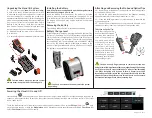
General Information
General Information
Product description
Product description
The MOHR CT100 / CT100HF Automated Metallic Time-Domain Reflectometers (MTDRs) use a
form of closed-circuit radar known as Time-Domain Reflectometry (TDR) to test cables for defects.
These instruments apply a very fast risetime step signal to the cable under test and then measure
the reflected voltage at very short time intervals. The resultant TDR trace allows the operator to
identify changes in impedance within the cable indicating the presence of faults such as opens,
shorts, kinks, defects in the shield or conductor, foreign substances such as water, or thermal
damage. The CT100 and CT100HF can find extremely subtle cable defects that may be missed
by other testing devices.
The CT100 series TDRs have specifications unmatched by any other commercially-available
metallic TDR cable tester. Both devices feature timebase resolution of 0.76 ps regardless of cable
length, equivalent to approximately 75 μm in coaxial cable with a Vp of 0.66. This allows for
extremely precise cable length measurements and localization of cable defects. Fast system
risetimes ensure excellent spatial resolution and make these instruments particularly valuable for
troubleshooting modern high-frequency analog/RF and digital communications systems.
The CT100 is able to perform continuous sequential sampling at up to 250 kHz, continuously
acquiring up to 500 full 500-point TDR traces per second. In concert with the CT100's high-speed
internal 32-bit processor, this allows for rapid automated cable scans, sophisticated real-time
digital filtering techniques (averaging, subtraction, derivatives, and more), and accurate
characterization of transient cable defects.
The CT100 can store hundreds of full-length high-resolution cable scans or several thousand
short or lower-resolution cable scans in its standard 2 GB internal non-volatile flash memory.
These scans are easy to call up for comparison so that changes in cable integrity over time can be
accurately assessed. To enter data, use the built-in software keyboard or plug an external
barcode reader or keyboard into the front-panel USB connector. It is easy to connect the CT100
to a host PC using 10/100 Ethernet or USB to view, analyze, and store your data.
In the remaining sections, the specific requirements, capabilities, and operation of the CT100 and
CT100HF are described in detail. Unless otherwise specified, any reference to the CT100 is true
of the CT100HF as well. Figures in this text were acquired using both CT100 and CT100HF
devices.
Mohr CT100 / CT100HF Operator's Manual
1












































